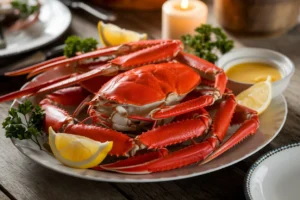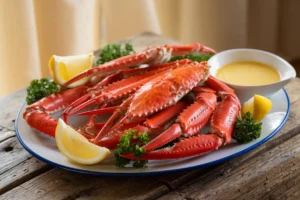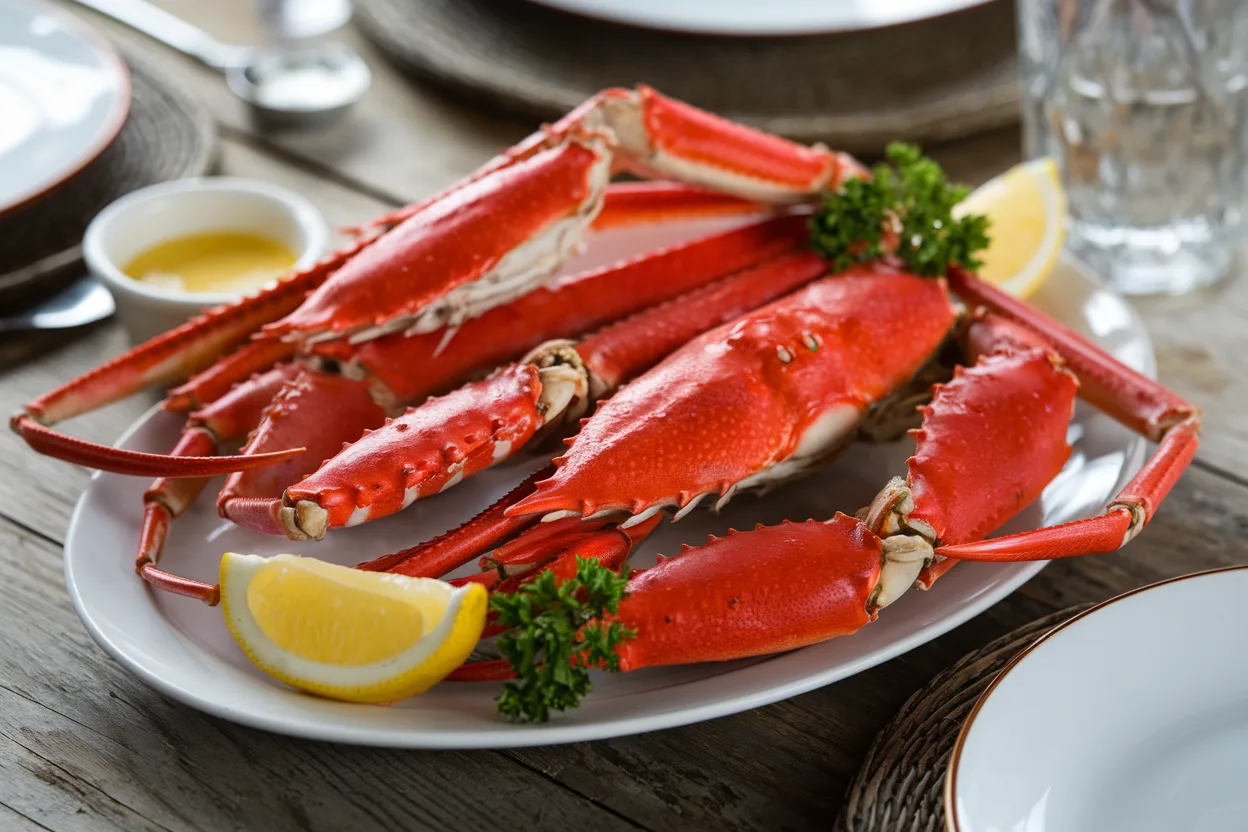
Overview of Snow Crab Legs
Snow crab legs are a beloved delicacy in the seafood world, known for their tender, flavorful meat and ease of preparation. These crustaceans are harvested from cold ocean waters, where they thrive, providing a sustainable and versatile seafood option. Their sweet and delicate flavor, paired with a slightly fibrous texture, makes them a favorite for seafood lovers worldwide.
Why They Are a Popular Seafood Choice
Snow crab legs are highly sought after for their convenience and culinary versatility. They are easy to crack open, offering accessible meat that pairs well with a variety of seasonings and dips. Their nutritional benefits, including being a lean source of protein, further add to their appeal, making them an excellent choice for health-conscious individuals.
2. What Are Snow Crab Legs?
Description and Key Characteristics
Snow crabs, also known as Chionoecetes, have long, slender legs with a distinctively sweet and delicate meat. Their exoskeleton is typically light brown or reddish in color, with white undersides. Snow crab legs are usually sold pre-cooked and frozen, making them convenient for home preparation.
How They Differ From Other Types of Crab
Compared to king crab legs, are smaller and easier to handle, often providing a more affordable option. Unlike blue crabs, which are known for their claw meat, snow crabs offer a higher yield of leg meat. Their flavor is also milder and less briny than other crab varieties, making them versatile for various dishes.
3. Types of Snow Crabs
Common Species of Snow Crabs
- Chionoecetes opilio: Commonly referred to as opilio crab, this species is the most widely consumed.
- Chionoecetes bairdi: Also known as tanner crab, this species is larger and offers slightly sweeter meat.
Where They Are Typically Found
Snow crabs are primarily found in the cold waters of the North Atlantic and North Pacific Oceans, including areas such as Alaska, Canada, and the Barents Sea. These crabs thrive in deep-sea environments, where the temperatures are consistently low.
4. Nutritional Benefits of Snow Crab Legs
Protein Content and Low-Calorie Benefits
A 3-ounce serving typically contains around 15-20 grams of protein and fewer than 100 calories, making them a lean and nutritious choice.
Vitamins and Minerals Present
- Vitamin B12: Supports nerve health and red blood cell production.
- Zinc: Enhances immune function and promotes healing.
- Selenium: Acts as a powerful antioxidant.
5. How to Choose Fresh Snow Crab Legs
Signs of Freshness
When selecting crab , look for these signs of quality:
- A mild, ocean-like scent (avoid any strong or fishy odors).
- Firm and moist shells with a natural sheen.
- Minimal ice crystals if frozen, indicating proper storage.
Frozen vs. Fresh Options
- Fresh Snow Crab Legs: Ideal for immediate consumption, offering peak flavor.
- Frozen Snow Crab Legs: A convenient option with a longer shelf life, often pre-cooked to lock in freshness.
6. How to Cook Snow Crab Legs
Boiling, Steaming, and Grilling Methods
- Boiling: Submerge crab legs in salted boiling water for 4-5 minutes.
- Steaming: Place crab legs in a steamer basket over boiling water for 6-8 minutes.
- Grilling: Brush crab legs with butter, wrap in foil, and grill over medium heat for 5-7 minutes.
Tips for Best Flavor and Texture
- Do not overcook, as this can make the meat tough.
- Pair with melted butter, lemon juice, or seafood seasonings for enhanced flavor.
7. Popular Recipes Using Snow Crab Legs
Classic Butter-Dipped Crab
A timeless favorite, this recipe involves steaming crab legs and serving them with clarified butter infused with garlic or lemon.
Crab Pasta and Soups
Snow crab meat adds a luxurious touch to pasta dishes and seafood bisques. Combine it with cream-based sauces or use it to enhance the flavor of a hearty chowder.
Snow crab , with their delicate flavor, nutritional benefits, and ease of preparation, remain a versatile and crowd-pleasing addition to any meal. Whether you enjoy them simply steamed or incorporated into elaborate dishes, they are sure to impress.
8. Serving Suggestions
Pairing Snow Crab Legs with Side Dishes
crab legs pair beautifully with a variety of sides to create a complete meal. Popular options include:
- Starches: Garlic butter rice, baked potatoes, or creamy mashed potatoes.
- Bread: Crusty French bread or soft dinner rolls for soaking up sauces.
Sauces and Condiments for Enhancement
Elevate the flavor of snow crab legs with complementary sauces and condiments:
- Clarified Butter: A classic choice, sometimes infused with garlic or herbs.
- Cocktail Sauce: Offers a tangy and slightly spicy accompaniment.
- Lemon Garlic Aioli: Adds a creamy and zesty flavor.
- Spicy Remoulade: Ideal for those who enjoy a kick of heat.
9. Sustainability and Snow Crab Fishing
Practices to Ensure Sustainability
Sustainable snow crab fishing involves quota systems, size limits, and fishing seasons to protect the crab population and their habitats. These measures ensure that snow crab populations remain robust for future generations.
Impact of Overfishing
Overfishing disrupts marine ecosystems and threatens the long-term viability of snow crab populations. Adhering to regulations and supporting sustainably certified fisheries can minimize environmental harm.
10. Cost and Availability
Market Prices and Seasonal Availability
Snow crab legs are generally more affordable than king crab legs, with prices varying based on size, season, and region. Their peak availability is during the winter and spring months, though frozen options are available year-round.
Where to Buy Snow Crab Legs
You can purchase snow crab legs at:
- Supermarkets (fresh or frozen seafood sections).
- Local fish markets for the freshest options.
- Online seafood retailers offering doorstep delivery.
11. Common Allergen Information
Allergic Reactions to Shellfish
Snow crab legs are a type of shellfish, a common allergen that can trigger reactions such as hives, swelling, difficulty breathing, or gastrointestinal distress. Individuals with shellfish allergies should avoid consuming them.
Cross-Contamination Risks
Cross-contamination can occur during processing or preparation. It is crucial to use separate utensils and surfaces when handling crab legs if preparing meals for someone with allergies.
12. Storage and Handling Tips
How to Properly Store Snow Crab Legs
- Fresh Crab Legs: Store in the refrigerator and consume within 1-2 days.
- Frozen Crab Legs: Keep in a sealed, airtight bag in the freezer.
Maximizing Shelf Life
- Avoid refreezing thawed crab legs to maintain quality.
- Use vacuum-sealed bags to minimize freezer burn.
13. Cultural Significance of Snow Crab Legs
Snow Crab Legs in Global Cuisines
Are a cherished delicacy in various cuisines:
- North America: Often served with melted butter in seafood boils or as part of surf-and-turf meals.
- Asia: Used in sushi, tempura, or miso-based soups.
- Europe: Featured in Mediterranean-style pasta dishes or risottos.
Celebrations and Special Occasions
are frequently served at festive gatherings, holiday dinners, and seafood feasts, symbolizing indulgence and culinary luxury.
14. FAQs About Snow Crab Legs
1. How many legs is 1 lb of snow crab legs?
On average, 1 pound of contains 4 to 8 legs, depending on the size of the crab and whether the legs come with attached clusters (sections of the body containing additional meat). Larger legs will mean fewer in the pound, while smaller legs may increase the count.
2. How to cook snow crab legs from frozen?
Cooking crab legs from frozen is easy since they are usually pre-cooked. Follow these methods:
- Steaming:
- Add water to a large pot and place a steamer basket over it.
- Place the frozen crab legs in the basket, cover, and steam for 6-8 minutes.
- Baking:
- Preheat your oven to 375°F (190°C).
- Bake for 10-15 minutes until heated through.
3. Which is better: king crab or snow crab?
- King Crab: Known for its massive size, rich and slightly sweet meat, and firm texture. It’s more expensive and prized as a delicacy.
- Snow Crab: Smaller, sweeter, and easier to handle, with thinner shells. It’s more affordable and often preferred for everyday meals.
Verdict: King crab offers a premium, luxurious experience, while snow crab is versatile, budget-friendly, and great for frequent enjoyment. The choice ultimately depends on your taste and budget.

All About Snow Crab Legs
Snow crab legs are a culinary delight enjoyed by seafood lovers worldwide. Their sweet, tender meat and versatility in recipes make them a popular choice. Below, we explore everything you need to know about snow crab legs, from their nutritional benefits to cooking tips, while incorporating helpful internal links to other resources.
1. Introduction to Snow Crab Legs
Are often featured in seafood boils and gourmet dishes. Their distinct flavor pairs well with a variety of sides and sauces, making them an excellent option for both casual dinners and special occasions.
For ideas on creative side dishes, check out Baked Beans with Ground Beef Recipe, which could complement your seafood feast.
2. Nutritional Benefits of Snow Crab Legs
Are a lean protein source, packed with essential vitamins like B12 and minerals such as zinc and selenium. Their low-calorie profile makes them a great addition to a balanced diet.
For more protein-rich recipes, you might explore the Simple Ground Beef Bulgogi Recipe, a flavorful dish to diversify your meal plan.
3. Cooking Tips for Snow Crab Legs
Are can be prepared using boiling, steaming, or baking methods. They are usually pre-cooked, so the focus is on reheating and enhancing the flavor.
- Boiling: A quick method to heat crab legs evenly.
- Baking: Great for infusing herbs and butter into the crab meat.
If you’re interested in slow-cooking techniques, see Can You Slow Cook Beef in 3 Hours? for inspiration on adjusting cooking times.
4. Recipes Using Snow Crab Legs
Snow crab legs can shine in simple recipes or complex gourmet dishes:
- Classic Butter-Dipped Crab: A quick dip in clarified butter highlights the natural sweetness.
- Seafood Pasta: Combine crab meat with creamy sauces for a luxurious dinner.
For more creative recipe inspiration, visit Unlocking Secrets Baked Beans with Ground Beef Recipe.
5. Pairing Suggestions
Snow crab legs pair wonderfully with buttery sauces, lemon garlic dips, and side dishes like roasted vegetables or seasoned rice.
For sides that balance your meal, try exploring Ground Beef Bulgogi Recipe for ideas on complementing flavors.
6. Sustainability and Cost
Sustainable fishing practices ensure the longevity of snow crab populations, but their cost can vary depending on the season. Frozen crab legs are a year-round option, making them more accessible.
By combining snow crab with creative side dishes and sustainable practices, you can enjoy this seafood delicacy in diverse ways. Use these internal links to enrich your knowledge and enhance your cooking repertoire!
15. Conclusion
Why Snow Crab Legs Remain a Beloved Seafood Choice
that continue to be a favorite due to their delicate, sweet flavor, nutritional benefits, and versatility in the kitchen. They can be enjoyed in countless ways, making them suitable for both simple meals and elegant dining.
Encouragement to Enjoy Them in Various Dishes
Whether served steamed with butter, added to a pasta dish, or included in a seafood boil, are a culinary treasure worth exploring. Their ease of preparation and universal appeal make them a delightful addition to any menu.

